CES 2010 TV Trends - 3D, Ridiculously Thin and Connected
by Manveer Wasson on January 9, 2010 5:00 PM EST- Posted in
- Trade Shows
This was the first year that CES wasn't predominantly a display show. Despite the focus on tablets, smartbooks, netbooks, eReaders and other wireless tech, the display guys were all there in full force.
All of the major TV vendors (LG, Panasonic, Samsung, Sony and Toshiba) held press conferences the day before the show officially opened. We spent the past day looking at all of the TVs and tried to get a feel for what improvements you can expect in 2010.
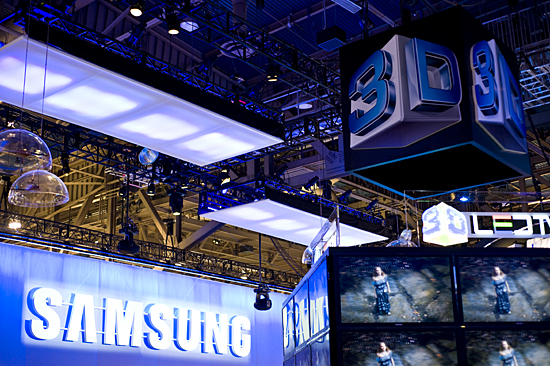
In 2009 we saw the trend moving towards slimmer televisions with the use of LED backlighting. This year however, the hype is all about 3D. Although prototypes of these 3D sets were shown off in previous years, this year we saw a full lineup of 3D home theater solutions from all the major TV manufacturers. In just the past year we saw the release of several blockbuster 3D movies (Avatar, Monsters vs Aliens, Up!) and CE companies are banking on customers wanting the same 3D experience at home. In addition to the the TVs, we'll also see 3D content from providers like DirectTV, ESPN, Fox Sports, and Dreamworks. We'll also see a complimentary lineup of Blu-Ray 3D capable players and HDMI 1.4 to push the content to the screen.
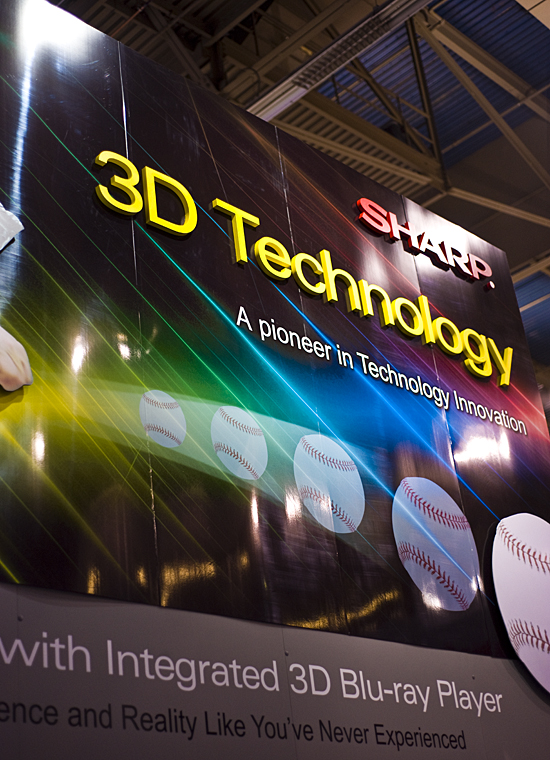
Toshiba, Samsung and Sony are also advertising the ability to convert 2D content into 3D in real time on their respective sets. Each of course claims to have the "best" implementation of this functionality (Toshiba even uses the Cell processor).
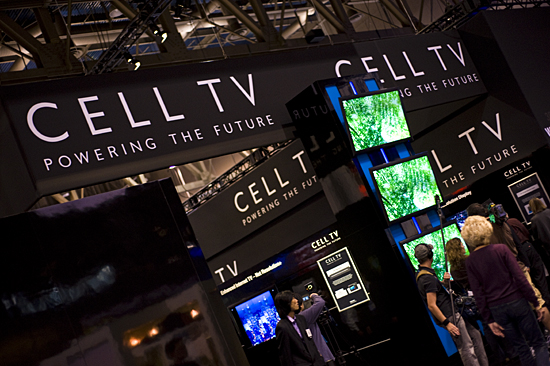
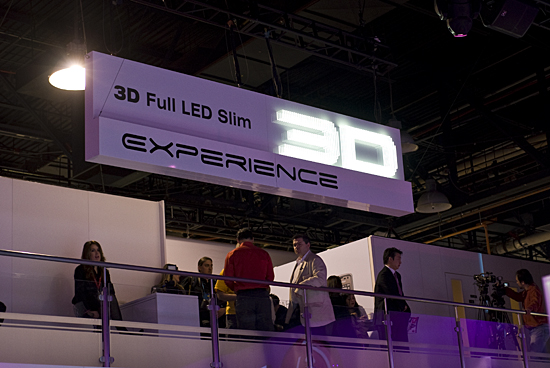
We had a chance to check out some of the 3D offerings on the show floor today to see if these sets lived up to the hype. The implementation of 3D varies slightly between manufacturers however for the most part all the major players are using active-shutter glasses to produce the 3D effect. This is the same technique used by NVIDIA's 3D Vision which we looked at last year . The glasses are required in order to view the 3D material properly, so if you and your friends want to enjoy a 3D movie, they'll need to each have their own pair of glasses.
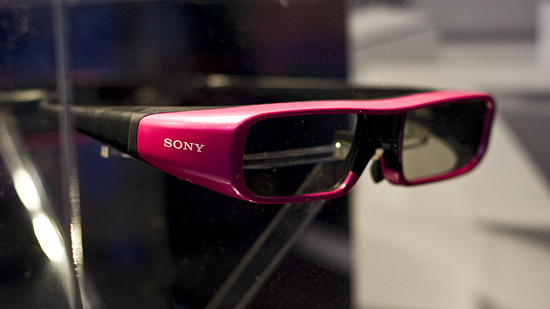
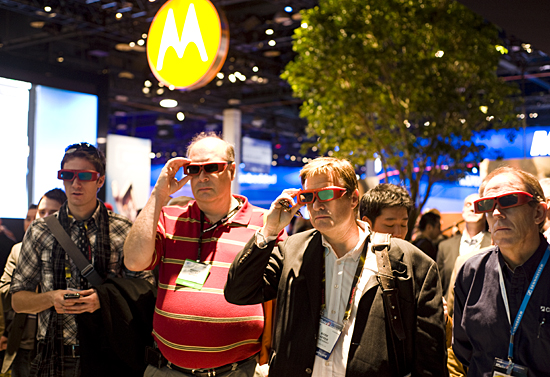
Active-shutter glasses communicate wirelessly to the TV to sync the shutters to the refresh rate of the set. If you have a TV with a 120Hz refresh rate, the TV will display a left or right frame of the stereoscopic image every 1/60th of a second, or at a rate of 60Hz, and your glasses will open the shutter of the corresponding eye. So essentially your 120Hz TV will be able to display 3D content at 60Hz.

A minimum of a 120Hz refresh rate is needed to ensure flicker-free 3D content delivery. Panasonic seems to going with the bare minimum here however Toshiba and LG are boasting refresh rates as high as 480Hz.
Another difference to note with this year's lineup of 3D devices is HDMI 1.4. This latest HDMI standard includes official support for stereoscopic 3D formats, however existing high speed HDMI 1.3 interfaces can also be used for 3D.
In our short time viewing the demonstrations on the show floor, we can say that the experience of 3D in the home is very similar to what you get at your local cinema, albeit on a smaller scale. Right now the price premium for 3D doesn't justify the experience, but perhaps that will change over time. Hopefully we will see more content that will push this technology artistically.
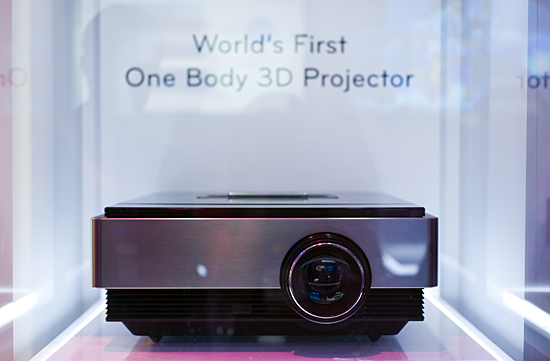
Another common theme for TV's this year was the broadening lineup of LED TVs. Although LED TV's have been selling for a few years now, the choices for these desirable sets have been slim and pricing was set at a premium. Expect the variety of LED based TVs to increase significantly for 2010. Of the 10 new Toshiba TV series' announced at the show, 7 will be LED. The LED sets also continue to get thinner as well with Samsung boasting that their LED9000 series set is 0.3" thick. LG takes the crown in being the "worlds slimmest" LED backlit LCD TV at 6.9mm (0.27") thick. In either case, they both look very slick with the LG set winning our approval for most elegant design. Sony however couldn't keep up in the thin race this year as all their LED backlit sets were noticeably thicker than the competition. Their "monolithic" design branding doesn't help invoke a feeling of thinness either.

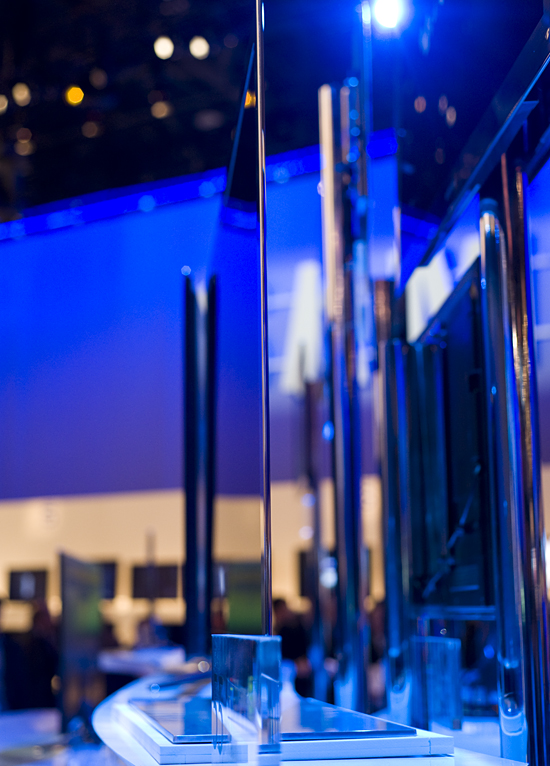
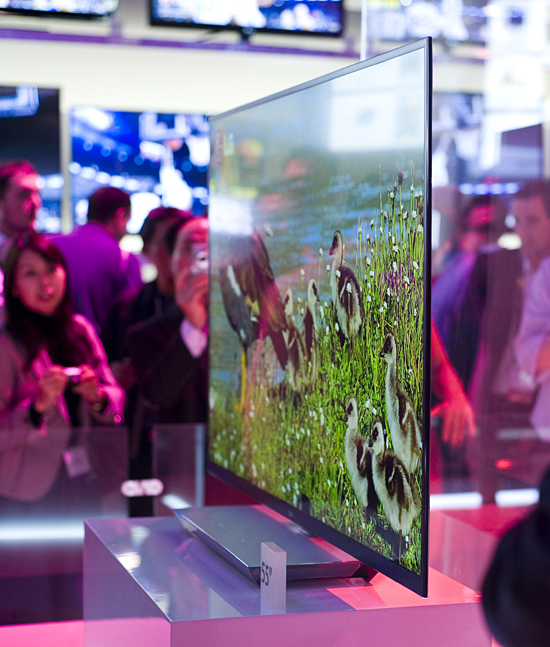
The ultra-thin TVs are arguably more interesting visually than 3D content displayed on them. It won't be too much longer before these things are light enough to hang directly on a wall or with minimal mounting hardware.
Finally this year saw a growing trend in "connected" TVs. These sets will integrate ethernet and wireless network capabilities to stream content from external devices and the internet. All the major brands were touting DLNA certified models that can view movies, music, and pictures stored on a network device directly on the TV. Samsung has upped the ante here by allowing their premium line of LED TVs (6000, 7000, 8000, and 9000 series) to run 3rd party apps. Samsung is calling their foray into an Apple-like app store "Samsung Apps" which expands on their Internet@TV service launched last year.
Companies like Samsung are moving in the right direction in terms of connected home entertainment with DLNA, however it still has a ways to go before it matures. If you already have a nice TV, it's not worth upgrading just for DLNA. Set top devices like the Popbox and the Boxee already provide the ability to stream almost any type of media to your TV in addition to streaming content like Netflix and Hulu.
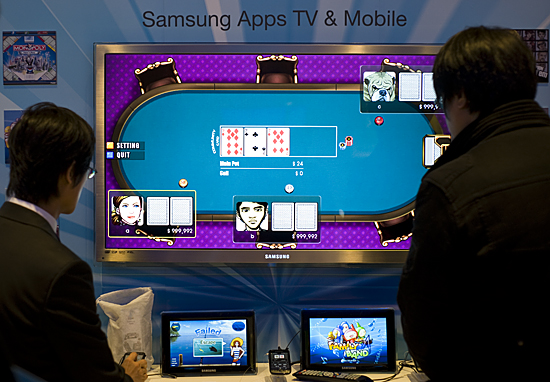










35 Comments
View All Comments
Galvin - Wednesday, January 13, 2010 - link
I'll wait until cannon comes out with their new tech that they won in court over or OLED comes out. I'd spend over 1K for a 24" OLED 1900x1200 computer monitor. For now I'll just hang on to my CRT. LCD panels them selves haven't changed in the last few years.Davelo - Monday, January 11, 2010 - link
Whatever happened to them?marc1000 - Monday, January 11, 2010 - link
has anyone noticed that these are the glasses from the 20 year old SEGA MASTER SYSTEM game console??? I had one of these, it worked with CRT TV's and at a uncomfortable slow refresh-rate (it depended on the interpolation of the TV to draw the images to the left and right eye, and eventually you could "see" the glasses opening and closing because of the slow refresh-rate), but given the current state of technology by that time, it worked great!anyway, this is exactly the same technology, but it took 20 years to come from a rough implementation to an acepptable one. LOL!
PS: I believe the guys from SEGA deserve the rightfull citation as being the first ones to implement this active-shutter-glasses, and not NVIDIA, they just made a copy of it.
kaborka - Sunday, January 10, 2010 - link
Sorry to nag, Manveer, but "complimentary lineup" s/b "complEmentary"rudy - Sunday, January 10, 2010 - link
If the stand to hold it up is huge. Clearly the one on the bottom has moved the electronics into the base. So how do you mount it on the wall. It always amazes me how dense consumers are. Unless you are putting a TV on a wall and flat against it there is no point in a TV that is less than 4 or 5 inches since you cant see behind it any way and the base is going to be at least a foot deep to hold it up. Yet they sell them like hot cakes.demonbug - Monday, January 11, 2010 - link
One of several things that has been driving me crazy since the push into LED LCDs is that they have been going for thinner rather than better. I would hazard a guess that all of these ultra-thin TVs are edge-lit, giving worse quality than back-lighting (which requires slightly thicker TVs).I also hate, Hate, HATE the addition of all the internet-connected BS in these new TVs. I don't want any of that, and most people who are likely to buy these probably already have a source that does everything they do (Xbox 360, PS3, HTPC, whatever).
medi01 - Tuesday, January 12, 2010 - link
I actually like network connectivity in TVs & internet crap in TVs. Provided it doesn't cost much (and it does not).What I HATE HATE HATE though, is LED back-lit TVs called "LED TVs".
strikeback03 - Monday, January 11, 2010 - link
I don't know that the bottom one has electronics in the base, might just need the weight so it doesn't blow over. As for why, it is the "It looks cool" thing, what sells lots of stuff.FlyTexas - Sunday, January 10, 2010 - link
I don't want to get off on a rant here, but I am NOT going to wear glasses in my living room to watch fake 2.5D pictures.This still isn't 3D, 3D would change the image depending on where I was sitting in the room.
Give us a real 3D image projected out in front of the TV, and I'll be impressed. Otherwise, this is just an attempt to raise the selling prices of current TVs.
Having just purchased 1080P LCD TVs in the last 2 years to replace our old tube TVs, it'll be another 10 years before we're ready to replace them again.
BTW, I watched "3D" back in the 80s at Disney World. This is not new technology, just slightly better because it uses active shutter glasses rather than the red/blue glasses. Same effect however...
flexy - Tuesday, January 12, 2010 - link
sorry to say you have NO clue what 3D tech nowadays is about. You cant even compare this what you saw "in the 80s". Do me favor see avatar or a recent 3D movie in Imax.I myself already own a 50" 3d plasma. Real field sequential 3d will be the future, whether you accept it or not.